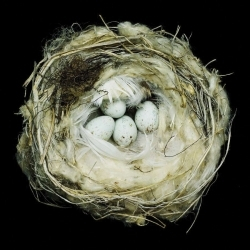
Nests
Each bird’s nest, like a great work of beauty and design, tells its own story. Reflecting the remarkable variations found in their builders’ plumage, nests are the perfect balance of form and function. These delicate constructions shelter, hide, and house their fragile fledglings from summer storms and deadly predators. But the greatest threat to nests and the birds that build them is often humanity. Throughout the nineteenth and early twentieth centuries, amateur collecting of nests and eggs and enthusiastic scientific study drove several species to near extinction.
Since the practice of collecting most nests and eggs was outlawed, much of the pressure it placed on some species has ebbed. Happily, many of the private collections may now be found in natural history museums around the world. And with San Francisco photographer Sharon Beals’ new coffee table book, Nests, fifty of the most aesthetically stunning treasures come out of three such institutions into the hands of readers.
Beginning in 2007, her work on Nests initially focused on collections at the California Academy of Sciences’ Museum of Vertebrate Zoology. The mid-project publication of her photographs in Audubon magazine’s April 2008 issue gave her subsequent access to collections at the Western Foundation of Vertebrate Zoology. All the specimens in this book reflect the geographic diversity of these collections, with nests from western and central North America, eastern Asia, and South America.
Centered against a solid black background, high-resolution photographs recall the sharp details of seventeenth-century Dutch still-life paintings. The eclectic mix of materials used in each nest, from skulls and moss to yarn and seashells, not only captivates the eye but also hints at each bird’s world.
On the page opposing each photograph, an ornithological watercolor by Laurie Wigham introduces readers to the birds who built the nest. Beneath, a brief essay by Beals places the species and the structure within its environmental and historical context.
The pairings work well. By removing the nests from their natural settings, readers experience the constructions at an abstract level. The supplemental information enhances this interaction by expanding on the complex and unique story each nest tells about the bird’s lifecycle and its habitat.
Known for her environmental work and inventive portraiture, Beals’ exhibits have hung in SFMOMA, the Strybing Arboretum in Golden Gate Park, and the University of California, Berkeley’s Museum of Vertebrate Zoology.
Reviewed by
Joseph Thompson
Disclosure: This article is not an endorsement, but a review. The publisher of this book provided free copies of the book to have their book reviewed by a professional reviewer. No fee was paid by the publisher for this review. Foreword Reviews only recommends books that we love. Foreword Magazine, Inc. is disclosing this in accordance with the Federal Trade Commission’s 16 CFR, Part 255.
